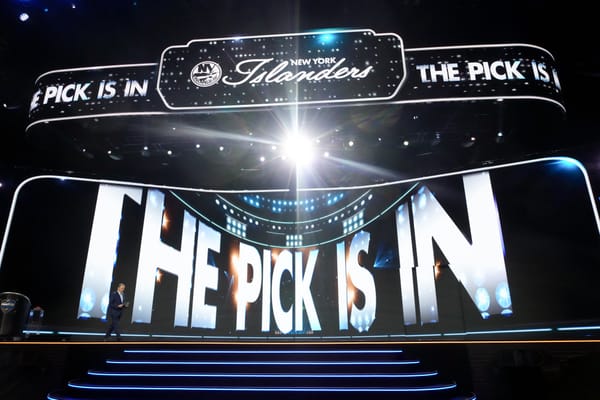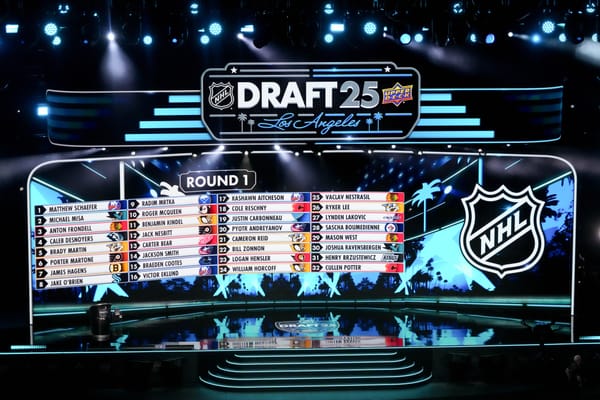Changes to Kravtsov’s Game Cause for Electric Start to KHL Season
After a tumultuous 2019-20 season, Kravtsov has made improvements and they’re paying off.
With the NHL schedule askew, the Rangers sent Vitali Kravtsov to Traktor Chelyabinsk of the KHL to see game action and re-establish his game following a calamitous 2019-20 season.
It’s hard to imagine a better start to the KHL season for the 2018 ninth overall pick. Through six games, the Russian has five goals. Furthermore, the goals aren’t just isolated tallies on a stat sheet but are the output of many great things he has done to put himself in positions to impact the game. Kravtsov has produced an outstanding 29 shots on goal, giving him an average of 4.83 shots-per-game. This is particularly encouraging because Kravtsov’s lack of shot generation both in the AHL and KHL was a major biggest red flag for him last season.
Kravtsov is scoring more goals in part because he’s getting more pucks to the net, as the old trope goes. But it’s not simply that he’s deciding to shoot more. Rather, a major problem last year was that Kravtsov struggled to find himself with the puck in shooting situations. What has changed?
As a preamble, the environment around him is completely different. Yes, Kravtsov struggled mightily in 11 KHL games last season before he was demoted to Russia’s second-tier league, the VHL. But Traktor on the whole were a totally dysfunctional, falling well below preseason expectations and finishing 21st out of 24 teams. This summer the team brought back its head coach from the 2017-18 season, under whom Kravtsov thrived, and improved the roster with major additions such as former NHLers Lawrence Pilut and Pontus Aberg. The team is more talented and better tactically organized, and a rising tide lifts all boats.
Still, Kravtsov himself clearly used the pseudo-offseason caused by the pandemic to make major improvements to his own game.
His skating, which in the past was a cause for concern in many scouts’ eyes, is at a different level. His first initial strides are quicker, allowing him to get to loose pucks more quickly, and he’s capable of higher top speeds in straight lines.
Note: Thanks to our friend Alex Nunn for putting up with me and cutting all video in this article at my request. Kravtsov is wearing #74.
These particular clips show him backchecking, which is also great to see, but the way he is able to make up ground are translatable examples for when he’s moving through the neutral zone on offensive possessions. Here’s one of his goals from Thursday.
Vitaly Kravtsov scores a beauty for his fourth of the season. #NYR pic.twitter.com/aI4xe4N7m4
— Alex Nunn (@aj_ranger) September 17, 2020
Great stickhandling by Kravtsov to beat defenseman Jakub Jerabek (who didn’t exactly hold a defensive clinic) and tremendous job disguising his shot release to fool the goaltender, but those qualities to his game were never in question. The difference here is the jump in his step the moment he recognizes there’s a puck up for grabs in the neutral zone. Last season, he likely loses that race and the opposition kills the play.
Kravtsov is never going to be the fastest skater on a team, and that’s fine. But last season his mediocre skating cost him. It hurt his ability to get involved in plays and he struggled to separate himself from the opposition on transition or rush chances. He’s since seemingly developed another gear, which is at least enough to not hold him back.
He also looks much stronger. Kravtsov’s willingness to battle wasn’t in question last season so much as his capability to withstand physical confrontations. In Hartford he got knocked off the puck too easily at times. This possibly was a factor in him forcing plays often to the chagrin of the coaching staff, as he felt pressure to get rid of it before he lost it himself.
So far this season for Traktor, he’s shown more capability in holding the puck through contact.
Despite the backchecker hanging all over him, Kravtsov doesn’t shy away from the play, uses his hind leg to maintain his balance and shield the puck, and then calmly makes the pass back to the right wing. Strength in hockey isn’t only about developing stronger muscles, but also about leveraging body positioning.
Finally, Kravtsov is moving his feet off of the puck. If you look at his highlight reels in previous seasons, even when he was scoring, you’re going to see a number of examples of him hovering around the circles or the high slot, receiving a puck, and then picking the goaltender apart with a great wrist shot. That ability of his is well and good, and it’s one part of his skillset that makes him an exciting prospect. But unless a player’s shooting ability is unequivocally elite (Alexander Ovechkin, Patrik Laine, etc.), it’s not enough. Especially on the constricted North American ice surface. Too often in Hartford last season Kravtsov would be hovering in his favorite spots waiting for the play to find him. It often didn’t, and when it did he still didn’t have the time and space he wanted to figure out how to make the best of a fleeting opportunity. That was a major reason for his low shot-on-goal numbers.
He’s engaged in the play off of the puck way more now. When you’re staying in one spot, it makes defending easier for the opposition. They know where you are, they know where you want to be, and they’re not forced to move much. Defensive zone breakdowns are often the result of disorganization in trying to adapt to the movement of the puck and players with it.
He doesn’t lose any momentum after the initial pass from the corner. He keeps his feet moving just the same and gets into position again to receive a pass. His movement (and that of the puck and his teammates) creates disarray for Sochi, and that confusion frees Kravtsov for a wide-open shooting opportunity.
Along similar lines, he’s moving into the middle lane and slot areas of the offensive zone more often. Check out this example, where after passing his immediate instinct is to keep his feet going and cut towards the net-front even with bodies already there.
At no point does he peel off, even if it may have been tempting to do so and head towards the boards for a pass to where he’s more comfortable navigating with the puck. But he uses his large frame and leverage to shield off the defender and make room for a deflection opportunity. It didn’t quite work out, but the intention was great. He scored his first goal of the season getting to the net front.
Vitaly Kravtsov scores his first of the season and it's beautiful. #NYR pic.twitter.com/pJWMdMWPPk
— Alex Nunn (@aj_ranger) September 6, 2020
Should there be concern about his zero assists? Probably not. That goose egg is not for lack of effort. He’s provided teammates with opportunities that have failed to find the back of the net so far.
Another standout play from Vitaly Kravtsov tonight. Steals possession and hits Lukas Sedlak (who really should score) with a backhand pass. Goes straight to the net after too. #NYR pic.twitter.com/SEuJPBXnjD
— Alex Nunn (@aj_ranger) September 15, 2020
Anyone calling Kravtsov a “bust” was being incredibly melodramatic, but concerns about Kravtsov’s development last season were absolutely warranted. His poor performance was a major wakeup call for him, it appears, and he put in a lot of work to become both faster and stronger. He’s learned his lesson about keeping his feet going in order to stay involved in plays all over the ice and create chaos on the ice that will afford him opportunities to get the puck in positions where he can then utilize his tremendous skill. When we think of needing to “get more pucks to the net,” it’s often under the premise of passing up shooting opportunities. In Kravtsov’s case, the problem was an inability to put himself in positions for potential shooting opportunities.
As hot as Kravtsov has started the season, it’s still just a six-game span. He’s not going to continue scoring and shooting at this current rate, but the general trend of generating offense as a result of these changes to his game must continue for the whole season.
With the acquisitions of Artemi Panarin, Kaapo Kakko, and now Alexis Lafreniere, it’s almost easy to forget just how highly thought of Kravtsov was after the Rangers drafted him. In many other organizations he’d their best hope for the future. At some point, the biggest test will be whether he can make it all work at higher speeds in North American pro hockey. For now, it’s a major sigh of relief that Kravtsov has made serious adjustments and has returned to the trajectory once hoped for him.




